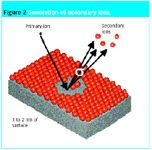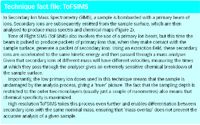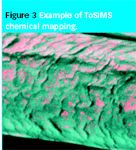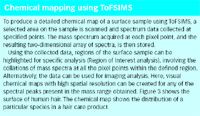News
Article
Pharmaceutical Technology Europe
Pharmaceutical Technology Europe
Tablet discolouration
Author(s):
We are currently experiencing a problem with one of our tablet lines. While the tablets appear white immediately after manufacture, after a time many of the tablets begin to take on a yellowish appearance. Could this be an issue that surface analysis could help resolve?
We are currently experiencing a problem with one of our tablet lines. While the tablets appear white immediately after manufacture, after a time many of the tablets begin to take on a yellowish appearance. Could this be an issue that surface analysis could help resolve?

Figure 1 ToFSIMS spectra of drug samples.
Discolouration issues present a very visible problem and can cost companies a great deal of money, regardless of whether the product (in this case a particular tablet formulation) itself is functionally affected or not.
But while the problem may be visible, the cause often isn't. The reason for this is that discolouration is almost always an issue that relates to surface conditions and not simply to bulk composition. Tiny variations in the outer nanometres of a particular tablet can be to blame for changes in appearance.
These variations are sometimes caused by contaminants that have penetrated the manufacturing process or, in other instances, by packaging treatments that lead to unforeseen chemical interactions. Occasionally, the chemical composition of the product surface reacts with the surrounding light and air, resulting in molecular conversion and possible changes in colouration.
All three of these scenarios are very different, but, as the resulting effects are confined to the surface of the products, any attempt to troubleshoot a solution using bulk analysis is likely to prove inconclusive, as it will not have the required sensitivity to discern the chemistry of interest and relevance. With this in mind, surface analysis could not only help you and your company, but also be the only conclusive solution.

Figure 2 Generation of secondary ions.
However, to say "surface analysis can help" is casting too broad a net, as there are numerous techniques encompassed by this description. For this particular product phenomenon I would initially recommend a programme of Time of Flight Secondary Ion Mass Spectrometry (ToFSIMS).
Other than its extreme analytical accuracy, the reason ToFSIMS is so suited to this scenario is that it is essentially nondestructive. As surface reactions could be the root of the discolouration, analysis techniques that alter or affect the sample's surface structure may also produce inaccurate data, or data that are true of lab conditions, but not manufacturing conditions. ToFSIMS provides an important and highly accurate troubleshooting solution.
So, which of the causes mentioned is the most likely scenario? It is impossible for me to say without access to the sample, but, given the time delay in the discolouration, I would favour some sort of reaction to light being the most likely cause. It is a more common issue than you might imagine, and one that we regularly see in the CSMA labs. A recent example of this may help to demonstrate.
A pharmaceutical sample submitted for ToFSIMS analysis displayed significant discolouration after manufacture. To assess the possible effects of light on the tablet formulation in question, a test was devised that analysed the following sample types:
- Pristine drug reference (control sample).
- Tablet prior to light exposure.
- Tablet exposed to light (Figure 1).
In the tablet exposed to light, ToFSIMS showed that selective degradation of the drug molecule had taken place where the acetic acid group (—CH2COOH) was converted to an aldehyde group (—COH). This resulted in the formation of a new molecule (Mdeg) with a mass of 30 less than the pristine drug reference (Mdrug), where M=molecular mass. As a consequence of this conversion (the actual process is caused by the interaction between the carbonyl group (C=O) and the 'aromatic ring'), a shift in the light absorption from the ultraviolet region of the electromagnetic spectrum had taken place (at least partially) into the blue region of the visible spectrum. This results in an outward appearance of yellowish discolouration.
In your question, you mentioned that 'many', but not all, of the tablets produced experienced discolouration. This could well support the theory that a surface reaction to light, along the same lines as those identified above, has taken place as the natural storage processes adopted by many manufacturers means that light exposure varies from batch to batch.

Technique fact file: ToFSIMS
Unfortunately, if your tablets react to light in this way then it is unlikely to be something that can be resolved without reformulating the drug itself, as it is the drug's basic structure and coating that result in this reaction, but that doesn't mean there is nothing that can be done. Although you can't change the reaction your tablets are prone to exhibit, you can manage manufacturing processes to eliminate the problem; for example, by adopting different storage and handling procedures, and by adapting packaging to prevent light degradation.
Speaking of packaging, I would reiterate that light sensitivity is just one possible cause that could be identified using surface analysis. Another potential explanation for the problem could be the packaging itself, or rather the migration of packaging components and treatments to the drug's surface.

Figure 3 Example of ToSIMS chemical mapping.
Ongoing advances in the formulation of polymeric materials used in packaging has resulted in a dramatic increase in the number of new chemical substrates capable of migration and, therefore, of causing product reaction, such as discolouration. This issue of migratory materials is one that has affected the pharmaceutical manufacturing industry for some time.
One common migratory problem identified through surface analysis relates to low molecular weight materials, which are by-products of the polymerization process. Packaging for products, such as pharmaceuticals and food stuffs, often requires multiple layered solutions. The 'contact' layers (i.e., those that are in direct contact with the drug surface), provide functionality in a sealing capacity. Then there are additional functional layers — this time concerned with maintaining structure and integrity, and ensuring that the drug is cocooned adequately by a protective barrier. The outermost layers provide little functionality, but are the cosmetic elements of the packaging that are required for the commercial market (often treated with inks etc). These multilayered packaging solutions are fused together using specially designed adhesives and primers, and are coated with numerous additional inks and treatments. Such materials often contain an abundance of low molecular weight materials and may migrate between layers. In some instances, they can migrate to the polymer surface that is in contact with the drug.

Chemical mapping using ToFSIMS
As with testing procedures where light is thought to cause discolouration, bulk analysis in this situation would be ineffective because pertinent surface information would be swamped by the 'good' chemistry from the bulk of the material.
ToFSIMS analysis provides a chemical breakdown of all substances present at the tablet surface, and identifies any potential molecular changes that low molecular weight materials may be prompting. Additionally, and particularly if discolouration is patchy, the process can be used to produce a chemical map of the sample surface, which gives an even clearer picture of where and how migratory materials are 'breaking through'.
Another potential cause of discolouration/contamination that is easily identifiable with ToFSIMS analysis, and once again related to packaging, is slip agents.
Slip agents are introduced during the mixing and extrusion stage of polymer film manufacture to reduce the Coefficient of Friction (the term used to measure the resistance to slip between two parallel polymer web surfaces). Like low molecular weight materials, slip agents are not bonded to the polymer bulk and are free to migrate through the to the surface — in effect, acting as lubricants.
But, depending on their molecular chain length, different slip agents react and behave differently with different bulk polymers. Miscalculations in compatibility can result in an undesirable migration rate, not only with regards to the time it takes slip agents to reach the polymer surface, but also with regard to the total amount that make and complete the journey to the outermost layers.
Once again, ToFSIMS analysis is an ideal identification tool for this scenario. ToFSIMS spectral analysis is used to identify slip agents present on the drug sample surface. Chemical imaging using ToFSIMS can be utilized to assess whether the presence of foreign species matches the discolouration region. If there is a correlation, surface analysis can then be used to compare and contrast samples exposed to polymers that utilize slip agents of differing molecular length to identify potential solutions to the problem.
In conclusion, surface analysis can be — and is often — used when pharmaceuticals display discolouration. And, as hopefully I have indicated in this edition of the Surgery, not only can analytical techniques such as ToFSIMS be used to identify potential root causes, they can then be used to assess the viability of alternative solutions. A practical solution to a potentially costly problem.
Shaun Bainbridge a chartered chemist, is sales & marketing manager at CSMA (UK) and has been with the company since 2003. Shaun promotes the features and benefits of surface analysis techniques to a wide range of sectors and disciplines, and provides valuable advice on troubleshooting and delivering analytical solutions for numerous commercial applications, including successful product development and reverse engineering.
Newsletter
Get the essential updates shaping the future of pharma manufacturing and compliance—subscribe today to Pharmaceutical Technology and never miss a breakthrough.






